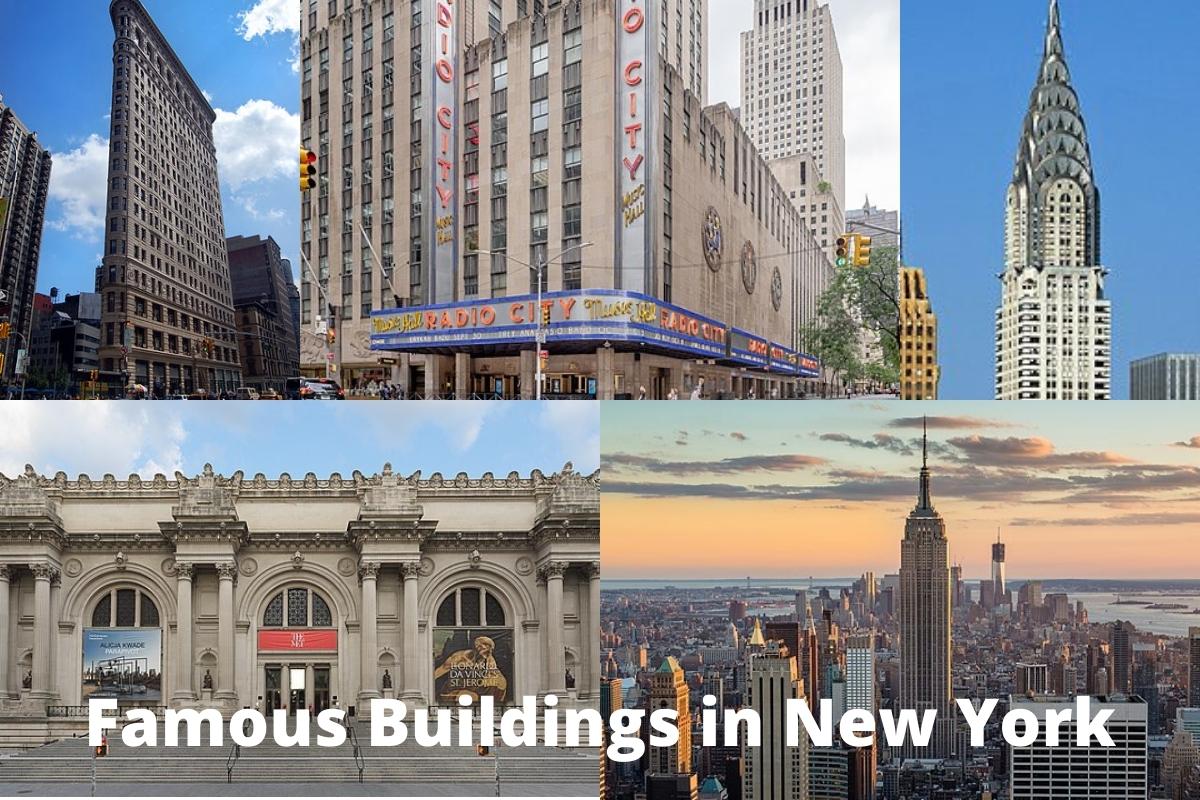New York has some of the most iconic buildings in the US with many of them being world famous.
As a city New York is one of the most densely populated in the USA and all of those people need to work and live somewhere!
Boasting one of the most famous skylines in the world it is it’s skyscrapers that dominate the horizon and give the city it’s signature look.
New York’s buildings are not all high rise though, as it is home to many great museums, churches, apartment blocks and monuments.
Below you will find some of most famous buildings in New York that has helped shape the big apple into the amazing city that it is today.
Famous Buildings in New York
1. Empire State Building
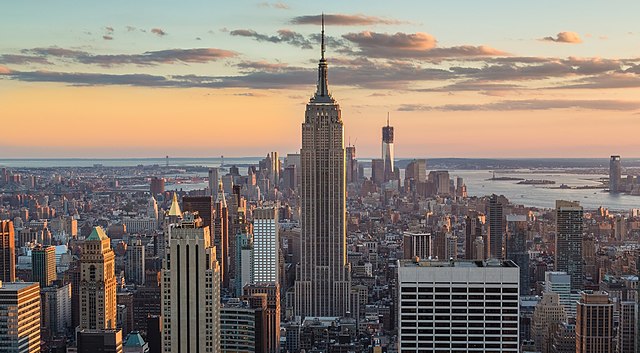
The Empire State Building is a Famous Art Deco building with 102 floors in Midtown Manhattan. The building was made by Shreve, Lamb, and Harmon. It was built between 1930 and 1931.
It got its name because New York is known as the “Empire State.” The roof is 1,250 feet (380 meters) high, and the building as a whole is 1,454 feet high (443.2 meters).
The Empire State Building was the tallest building in the world before the World Trade Center was built in 1970. After the World Trade Center fell in 2001, the Empire State Building was once again the tallest skyscraper in New York City until it was surpassed in 2012.
As of 2022, the building is the seventh-tallest in New York City, the ninth-tallest finished skyscraper in the United States, the 54th-tallest in the world, and the sixth-tallest freestanding building in the Americas.
The Waldorf–Astoria Hotel was built in 1893 on the west side of Fifth Avenue between West 33rd and 34th Streets, where the Empire State Building is now. In 1929, Empire State Inc. bought the land and made plans to build a tall building there.
The building didn’t open until May 1, 1931. Work on it began on March 17, 1930. Even though the building got a lot of good press when it was built, the owners didn’t start making money until the early 1950s because of the Great Depression and World War II.
It has become a popular place to visit because of its Art Deco style, height, and observation decks. Every year, four million people go to the 86th and 102nd floors of the building to see the observatories. On the 80th floor, there was a new observatory that opened in 2019.
2. Flatiron Building
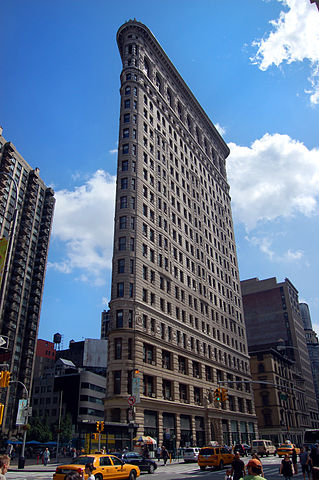
The Flatiron Structure, which used to be called the Fuller Building, is a 22-story, 285-foot-tall (86.9-m) steel-framed building in Manhattan’s Flatiron District. It is located at 175 Fifth Avenue.
When it was finished in 1902, it had 20 stories and was one of the tallest buildings in the city. It was also one of only two “skyscrapers” north of 14th Street, the other being the Metropolitan Life Insurance Company Tower, which is one block to the east.
A triangular block is made by Fifth Avenue, Broadway, and East 22nd Street. East 23rd Street touches the triangle’s northern (uptown) point. Like many other wedge-shaped buildings, the name “Flatiron” comes from the fact that it looks like a cast-iron clothes iron.
Also Read: New York Architects
The building, which has been called “one of the world’s most recognizable buildings and a fundamental symbol of New York City,” stands at both the south (downtown) end of Madison Square and the north (uptown) end of the Ladies’ Mile Historic District.
It is in the Flatiron District, which gets its name from a famous building in the area. In 1966, the building was named a New York City landmark. In 1979, it was added to the National Register of Historic Places, and in 1989, it was named a National Historic Landmark.
3. Chrysler Building
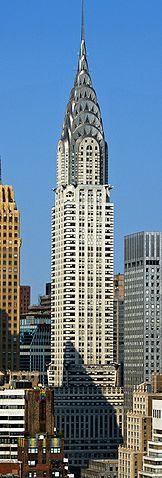
The Chrysler Building is an Art Deco skyscraper on the corner of 42nd Street and Lexington Avenue in Midtown Manhattan’s Turtle Bay neighborhood.
At 1,046 feet (319 meters), it is the world’s tallest brick building with a steel frame. When it opened in 1930, it was the world’s tallest building for 11 months. As of 2019, the eleventh-tallest building in the city is a tie between the Chrysler and the New York Times Building.
Walter Chrysler, who is the chairman and CEO of the Chrysler Corporation, made the building.
When the Chrysler Structure, one of the first skyscrapers, was being built, it competed with 40 Wall Street and the Empire State Building to be the world’s tallest building.
Even though the Chrysler Building was built and planned with the auto business in mind, the business never paid for it or owned it. Instead, Walter Chrysler paid for the whole thing out of his own pocket so that his children could keep it.
In 1952, an addition was built, and the Chrysler family sold the building the next year. It has since been owned by many other people.
When the Chrysler Building first opened, people had different things to say about its design. Some said it was boring and unimaginative, while others said it was modern and recognizable.
In 2007, the American Institute of Architects put it as the eighth best building in America. Over time, people’s ideas about the building have changed, and it is now seen as a great example of the Art Deco style.
In 1978, the building was named a New York City landmark. In 1976, it was added to the National Register of Historic Places as a National Historic Landmark.
4. St. Patrick’s Cathedral
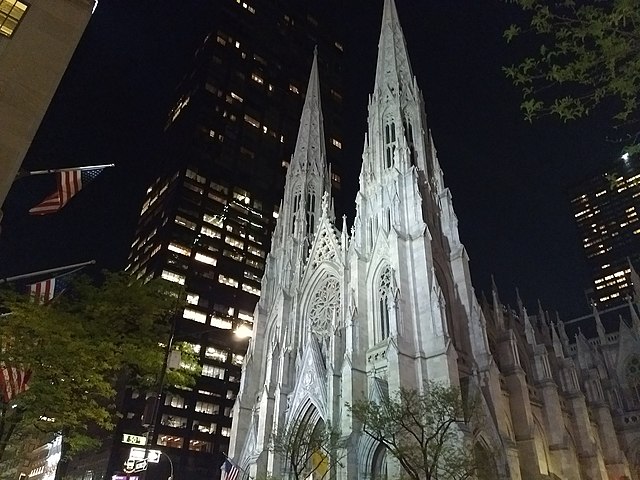
The Catholic St. Patrick’s Cathedral is in the Midtown Manhattan neighborhood of New York City. It is both a parish church and the home of the Archbishop of New York.
The cathedral is on a city block between Fifth Avenue, Madison Avenue, 50th Street, and 51st Street. It is right across the street from Rockefeller Center. It was made by James Renwick Jr. and is the largest Gothic Revival Catholic cathedral in North America.
The cathedral was built starting in 1858 to serve the growing Archdiocese of New York and take the place of St. Patrick’s Old Cathedral.
Also Read: Churches in New York
The American Civil War stopped work on the cathedral in the early 1860s, so it wasn’t finished until 1878. It was dedicated on May 25, 1879.
In the early 1880s, James Renwick Jr. built the archbishop’s home and rectory. The spires went up in 1888. A Lady chapel by Charles T. Mathews was built from 1901 to 1906.
When the cathedral’s debts were paid off on October 5, 1910, it was dedicated. Many times, especially in the 1940s, 1970s, and 2010, the cathedral has had major repairs.
Marble covers St. Patrick’s Cathedral, and it has a lot of stained glass windows. At the transepts, it is 332 feet (101 meters) long and 174 feet (53 meters) wide.
The main entrance to the cathedral is on Fifth Avenue. On either side of the entrance are towers with spires that rise 329.5 feet (100 m). Inside, there are two pipe organs and nineteen bells in the northern tower.
Inside, there is a nave with chapels on either side, two transepts, a chancel, apse, and crypt. The rectory, Lady chapel, and archbishop’s home are all to the east of the apse, facing Madison Avenue.
The cathedral is on the National Register of Historic Places and is a recognized landmark in New York City.
5. One World Trade Center
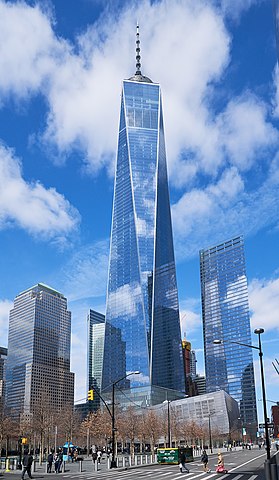
One World Trade Center is the most important building in Lower Manhattan, which is part of the rebuilt World Trade Center complex in New York City.
One WTC is the tallest building in the United States, the seventh-tallest building in the world, and the tallest building in the Western Hemisphere. The name of the supertall tower is the same as the name of the North Tower of the first World Trade Center, which was destroyed in the terrorist attacks of September 11, 2001.
In the northwest corner of the 16-acre (6.5-hectare) World Trade Center complex, where the old 6 World Trade Center used to be, is where the new tower is.
The building was designed by David Childs, whose company Skidmore, Owings & Merrill (SOM) also made the Burj Khalifa and the Willis Tower.
On April 27, 2006, work began on the new building’s footings, foundations, and moving the utilities that were below the ground. On April 30, 2012, One World Trade Center became the tallest building in New York City. Before that, the Empire State Building was the tallest.
On August 30, 2012, the steel frame of the skyscraper was finished. On May 10, 2013, the last piece of the skyscraper’s spire was put in place. This made the building’s total height, including the spire, 1,776 feet (541 m).
The number of feet in its height stands for the year that the United States Declaration of Independence was signed. The building opened on November 3, 2014, and the observatory opened on May 29, 2015.
On March 26, 2009, the Port Authority of New York and New Jersey said that the building will be known by its legal name, “One World Trade Center,” instead of its common name, “Freedom Tower.” The building has 94 floors, with the 104th floor being the highest.
Also Read: Landmarks in New Jersey
Along Greenwich Street, five high-rise business buildings will be built, and the National September 11 Memorial & Museum will be built where the original Twin Towers stood, just south of One World Trade Center.
After the old World Trade Center complex was torn down, the new building is being built as a way to remember and move forward.
6. Woolworth Building
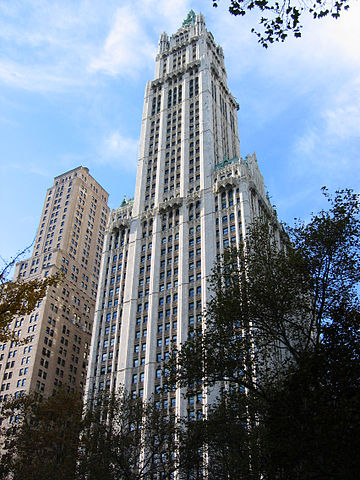
Cass Gilbert built the Woolworth Building in the early 1900s. It is located at 233 Broadway in the Tribeca neighborhood of Manhattan.
792 feet tall, it was the tallest building in the world from 1913 to 1930. (241 m). Even though it was built more than 100 years ago, it is still one of the top 100 tallest buildings in the United States.
The Woolworth Building is surrounded by Broadway and City Hall Park to the east, Park Place and Barclay Street to the north, and Park Place and Barclay Street to the south. It has a base with 30 stories and a tower with 30 stories on top.
It has a lot of windows and is mostly made of architectural terracotta, but the lower parts are made of limestone. The beautiful foyer has sculptures, mosaics, and architectural details all over it.
The building was made with a lot of features and amenities, like an observatory on the 57th floor that is no longer open and a private swimming pool in the basement.
F. W. Woolworth, who started a successful chain of five-and-ten-cent stores, wanted the tower to be the headquarters for his company. Woolworth and the Irving National Exchange Bank worked together to design the tower, and the bank decided to use it as its headquarters.
The Woolworth Building was supposed to be a commercial building with 12 to 16 stories, but it went through many changes during the design process.
Not until January 1911 did they know what the final height would be. The building work started in 1910 and was done in 1912. On April 24, 1913, the building was officially opened.
The Woolworth Building has been a National Historic Landmark since 1966. Since 1983, it has also been a New York City landmark.
7. 30 Rockefeller Plaza
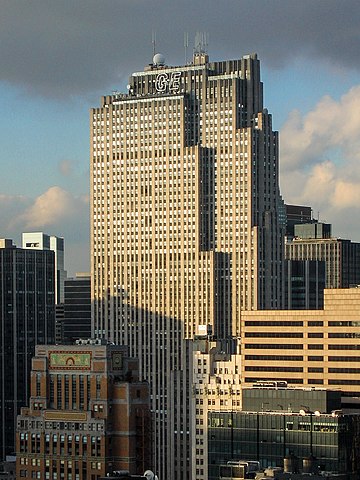
The tall building at 30 Rockefeller Plaza, which is now called the Comcast Building but used to be called the RCA Building and the GE Building, is the center of Rockefeller Center in Midtown Manhattan, New York City.
Raymond Hood, the main architect for Rockefeller Center, built the 66-story, 850-foot-tall (260-meter-tall) building in the Art Deco style. It was finished in 1933.
From 1933 until 1988, 30 Rockefeller Plaza was called the Radio Corporation of America (RCA). After that, it was called General Electric until 2015, when it was renamed after the company that now owns it.
The skyscraper is also home to NBC’s New York studios and headquarters. The headquarters is known as “30 Rock,” which is also the name of an NBC comedy show.
The building is the tallest in Rockefeller Center, the 28th tallest in New York City, and the 60th tallest in the United States.
8. Radio City Music Hall
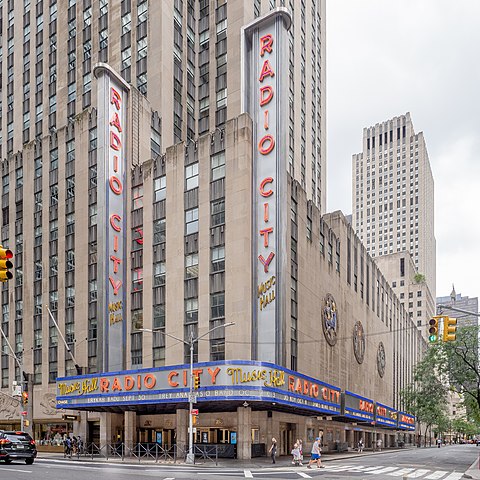
Radio City Music Hall is a place for entertainment and a theater. It is at 1260 Avenue of the Americas, which is inside Rockefeller Center in the Midtown Manhattan neighborhood of New York City.
It is where the Rockettes, a group of precise dancers, have their home. It is also called “the Showplace of the Nation.” The Art Deco style was used to build Radio City Music Hall by Edward Durell Stone and Donald Deskey.
Radio City Music Hall was built on a piece of land where a Metropolitan Opera House was supposed to go. That plan was scrapped in 1929. It first opened as part of the Rockefeller Center building on December 27, 1932.
The Center Theatre was the smaller of the two venues built for Rockefeller Center’s “Radio City” area. Eventually, the name “Radio City” was only used to describe the Music Hall.
It was mostly successful until the 1970s, when fewer people went to the theater, which almost caused it to close. Radio City Music Hall was named a New York City Landmark in May 1978. It was then fixed up and given permission to stay open. In 1999, the theater got a lot of work done to it.
9. The Dakota
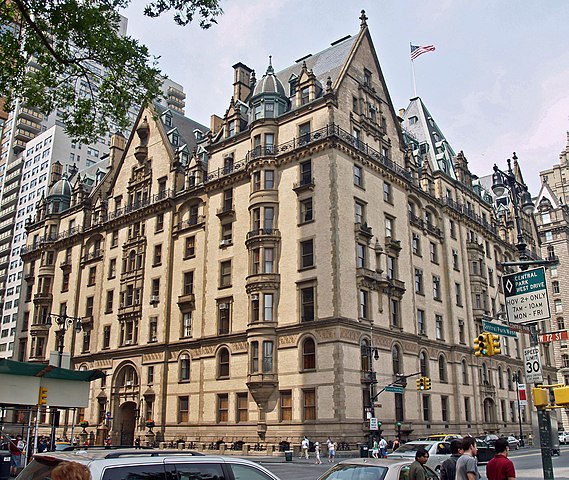
The Dakota, also called the Dakota Apartments, is a cooperative apartment building in New York City, United States. It is located at 1 West 72nd Street on Manhattan’s Upper West Side.
The Dakota was built between 1880 and 1884 in the Renaissance Revival style. It was built for businessman Edward Cabot Clark by Henry Janeway Hardenbergh.
The building is the oldest luxury apartment building still standing in New York City. It was one of the first big projects on the Upper West Side.
The building is a National Historic Landmark, and the New York City Landmarks Preservation Commission has named it a city landmark. The building is also part of the Central Park West Historic District as a contributing property.
The Dakota is between 72nd and 73rd Streets on the west side of Central Park West. It has a mostly square shape and is built around a “I”-shaped courtyard that all apartments enter through.
Before, there was a garden to the west of the Dakota. Below that garden was a mechanical plant that served the Dakota and some row houses nearby. Most of the facade is made of brick, with some sandstone and terracotta details.
A double-height archway on 72nd Street is the main entrance. It leads to the courtyard. Deep roofs with dormers, terracotta spandrels and panels, niches, balconies, and balustrades are all parts of the building’s design.
10. Solomon R. Guggenheim Museum
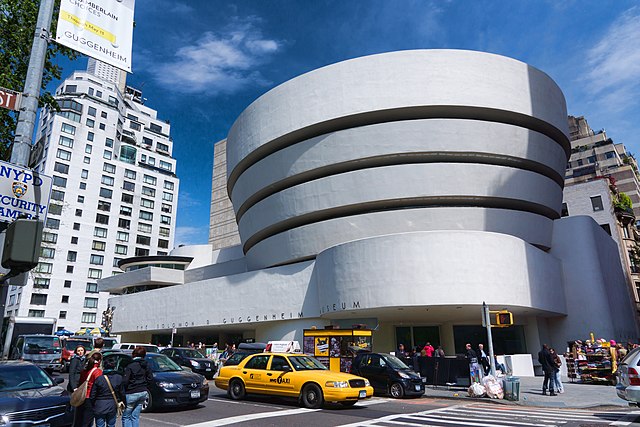
The Solomon R. Guggenheim Museum, also called The Guggenheim, is an art museum in Manhattan’s Upper East Side. It is at 1071 Fifth Avenue and East 89th Street.
It has a permanent collection of Impressionist, Post-Impressionist, early Modern, and contemporary art, as well as special exhibits that change throughout the year.
In 1939, the Solomon R. Guggenheim Foundation started the Museum of Non-Objective Painting. Hilla von Rebay was the first person in charge of the museum. It got its current name when its founder, Solomon R. Guggenheim, died in 1952.
In 1959, the museum moved from rented space to its current location, a major piece of architecture from the 20th century designed by Frank Lloyd Wright.
The cylindrical building, which is wider at the top than at the bottom, was meant to be a “temple of the spirit.” Its one-of-a-kind ramp gallery rises from the ground in a long, continuous spiral around the building’s outside walls, ending just under the ceiling skylight.
When a nearby tower was finished in 1992, the building went through a lot of changes and additions. This also happened from 2005 to 2008.
The Manhattan museum’s collection has grown over the past 80 years. It is made up of many important private collections, starting with Solomon R. Guggenheim’s.
The collection is shared with other museums, including one in Bilbao, Spain. Every year, about 1,2 million people go to the museum.
11. Metropolitan Museum of Art
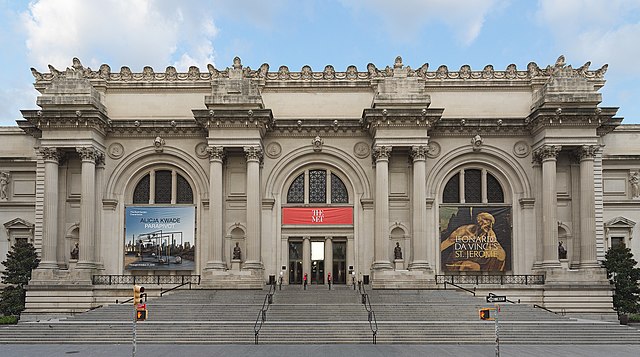
The Metropolitan Museum of Art in New York City is one of the largest art museums in the world. It is also known as “the Met.”
It has almost two million items in its permanent collection, which is organized into 17 sections by curators. The main building is one of the biggest art museums in the world in terms of space. It is at 1000 Fifth Avenue, on the Upper East Side of Manhattan, on the east side of Central Park.
The Cloisters in Fort Tryon Park in Upper Manhattan is a second, much smaller site with a large collection of art, architecture, and relics from the Middle Ages.
In 1870, the Metropolitan Museum of Art opened with the goal of bringing art and art education to the people of the United States.
The museum’s permanent collection has works of art from classical antiquity and ancient Egypt, as well as paintings and sculptures by almost all of the great European artists and a large number of American and modern works.
The Metropolitan Museum of Art has a huge number of pieces of art from Africa, Asia, Oceania, Byzantium, and Islam. The museum has a huge collection of historical weapons and armor from all over the world, as well as musical instruments, clothes, and other items.
In its galleries, you can see interesting interiors from the 1st century Rome to modern American design.
The 681 Fifth Avenue building, which opened on February 20, 1872, is called the Fifth Avenue building.
12. Madison Square Garden
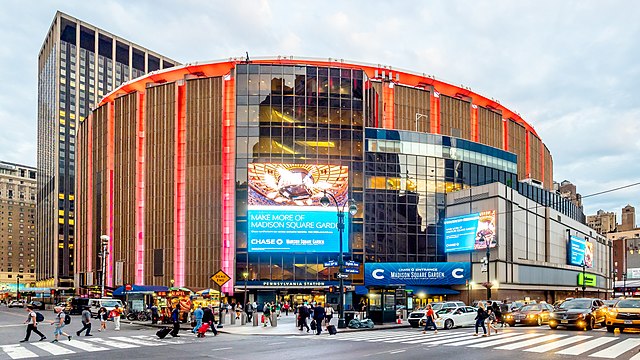
Madison Square Garden, also called “The Garden” or “MSG,” is an indoor arena in New York City that can be used for many different things. It is above Pennsylvania Station in Midtown Manhattan, between 31st Street and 33rd Street and between Seventh Avenue and Eighth Avenue.
It is the fourth place with the name “Madison Square Garden.” The first two, in 1879 and 1890, were on Madison Square, at East 26th Street and Madison Avenue. The third Madison Square Garden, in 1925, was further uptown at Eighth Avenue and 50th Street.
Professional ice hockey, basketball, boxing, concerts, ice shows, circuses, professional wrestling, and other sports and entertainment events take place at The Garden.
It is near the Empire State Building, Koreatown, and Macy’s at Herald Square, all of which are well-known places in midtown Manhattan. The New York Rangers of the National Hockey League (NHL) and the New York Knicks of the National Basketball Association (NBA) play there. From 1997 to 2017, the New York Liberty of the Women’s National Basketball Association (WNBA) also played there.
The Garden first opened on February 11, 1968, under the name Madison Square Garden Center. It is the oldest major sports venue in the New York metropolitan area.
It is the NBA and NHL’s oldest building. As of 2016, MSG is also the second most popular music venue in terms of tickets sold.
The total cost of building it, including two major renovations, was about $1.1 billion, and it has been named one of the 10 most expensive stadiums ever built. It is part of the office and shopping complex called Pennsylvania Plaza, which is named after the train station.
13. Trinity Church Wall Street
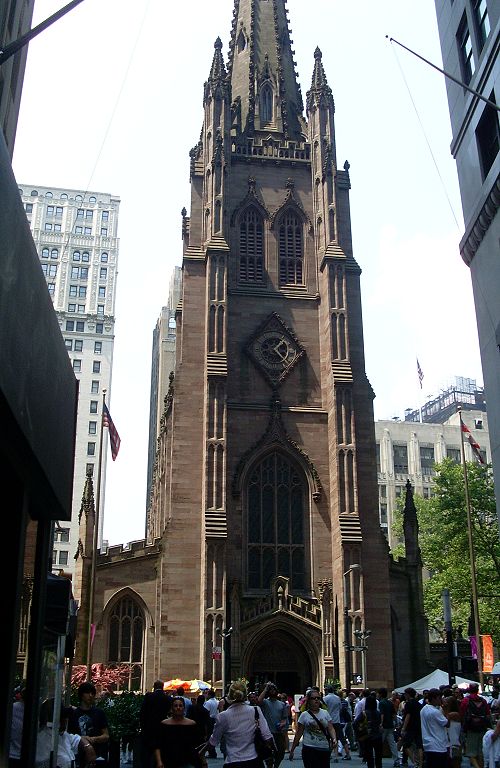
Trinity Church is a historic parish church in the Episcopal Diocese of New York. It is located in the Financial District of New York City, where Wall Street and Broadway meet.
Trinity is a historic high church known for its history, location, architecture, and endowment. It has an active parish based on the Episcopal Church and the international Anglican Communion in missionary, outreach, and fellowship.
Trinity also runs St. Paul’s Chapel and the Chapel of St. Cornelius the Centurion on Governors Island in addition to its main building. The Church of the Intercession, the Trinity Chapel Complex, and a number of other Anglican churches in Manhattan used to be part of Trinity.
Richard Upjohn used the Gothic Revival style to build Trinity Church’s third building, which is the one you see now.
The first building for Trinity Church was a rectangular church with one story that faced the Hudson River. It was built in 1698 and burned down in the Great New York City Fire of 1776.
In 1790, the second Trinity Church was opened. It faced Wall Street. The current church building was made between 1839 and 1846. Until 1869, it was the tallest building in the United States, and until 1890, it was the tallest building in New York City.
In 1876 and 1877, in honor of William Backhouse Astor Sr., the architect Frederick Clarke Withers added a reredos and an altar. He also made the back bigger.
The Trinity Churchyard is close to the church building. It is one of three areas used by the church. As of 2019, Trinity is also in charge of more than $6 billion worth of real estate investments.
The main building of Trinity is both a New York City landmark and a National Historic Landmark. It also helps the Wall Street Historic Site, which is part of an NRHP district that was set up in 2007.

